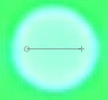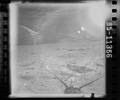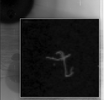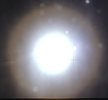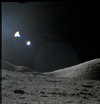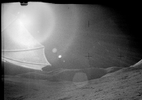Only when on the 'lunar' surface. Here's a snip of an over exposed sun from the Gemini missions and with levels adjusted.
View attachment 95780View attachment 95781
The spiky sun appears, when the camera settings are applied correctly you get this no need to adjust any levels, 10 spikes and a chain pentagonal lens flares. Typical of 1960s camera tech and happens today with digital SLR cameras with a 5 blade aperture. Provided you have a single bright light, the result is the same.
View attachment 95782View attachment 95783
This image was taken by Gene Cernan during the Gemini missions, one purpose of these missions was to hone space photography skills. Cernan was also commander of Apollo 17 and below is an example of his work, levels adjusted AS17-136-20762, AS17-136-20764 and AS17-136-20819.
View attachment 95785View attachment 95786View attachment 95787
Seems that Commander Cernan solar photography skills had diminished somewhat since his Gemini days! Where is the sun in these photos? I can see a disc shaped flare of varying shades, very different to my previous example: Faint horizontal and vertical lines but no sun. There's a short chain of flares but they're circular, not pentagonal and they point to where the source of light is which which seems to lie beyond the image's edge. If these images were overexposed there should still be 10 spikes radiating from a bright center because these images were taken through a lens that had a 5 bladed aperture. An aperture that could be cranked down to f/45, making it essentially a pinhole camera that could negate any overexposure and provide a dazzling depth of field but Commander Cernan wasn't up to it. None of them were, despite having extensive training and the guidelines glued to the top of their cameras. All we have is one single image in over 20000 snaps taken on the moon and in orbit!
Notice that the original arguments you presented are still seriously (in fact, pretty much totally) undermined by the two simple and pretty obvious statements/sentences mkrnhr presented:
That's an over-saturated image of the sun, not an image of the sun.
Here's a non-saturated picture I took yesterday with a pocket digital camera (through binoculars..):
View attachment 95325
There is a center to limb darkening. It's not evenly illuminating.
When the image is over-exposed, the sun appears larger than it is as in this shot:
View attachment 95324
But now you are arguing that some pictures can't be overexposed images because of the spike forms of the overexposed sun and/or the lack there of. Then you continue further down the "there must be something wrong" "rabbit hole", by statements like this:
All we have is one single image in over 20000 snaps taken on the moon and in orbit!
Ok then, I guess we have to address that one as well:
Let's just stay on earth for a moment and notice what most people have done and still do if they take pictures of anything (especially with older cameras/equipment): They purposefully avoid having the sun in the photo, because, well, they want to avoid an overexposed image! In other words: Unless you want to purposefully make a picture of the sun, most likely, the overwhelming majority of pictures taken by anyone on earth purposefully avoid having the sun in the shot. Which means, that on average, we can assume that pretty much anyone who has ever taken pictures on earth has only a very tiny percentage of photos that have the sun in it (if at all). And people on earth are also likely to throw pictures out that have a sun in it, because well, the image is too overexposed.
Furthermore, if we now go out of earths atmosphere, people usually also want to make sure to not have the sun in any picture EVEN MORE SO, because of this pretty simple/obvious fact:
While the Apollo astronauts took many photos of the Earth and lunar surface, they took no images of the Sun. Without the Earth's atmosphere protecting their cameras from harmful solar radiation, our star is able to destroy any imaging equipment.
And, as it turns out, the Apollo guys did actually take a number of pictures with the sun in it, probably more by accident and carelessness than anything else. And, they and/or NASA did in fact not publish or maybe even destroy some of those images, not because of a "conspiracy", but because of exactly the same reason you do it on earth: the image is too overexposed.
Also, notice that the last quote above, by another simple and obvious deduction, strongly points to the possibility that the reason for why the sun (or rather, the overexposed image of it) appears "so big" in some of the pictures you presented, is also very simple:
If you take a picture of the sun in space and/or on the moon, the image is much more overexposed, and thus it is likely, that the overexposed image of the sun is much bigger compared to earth, where the intensity of the light is filtered through layers of earths atmosphere.



